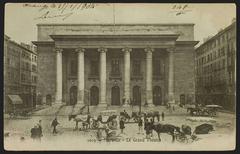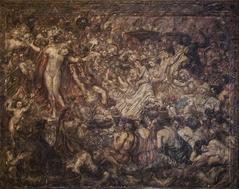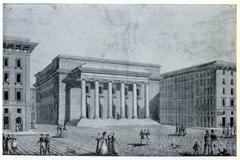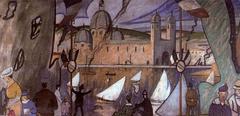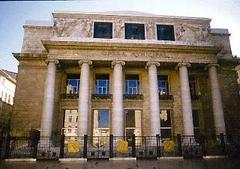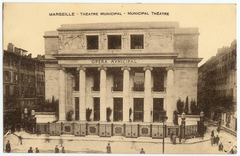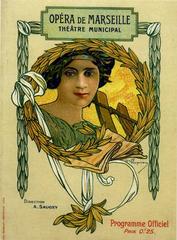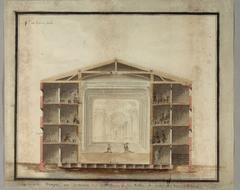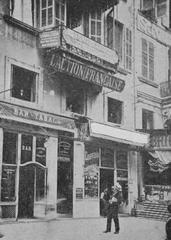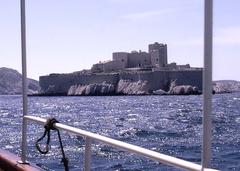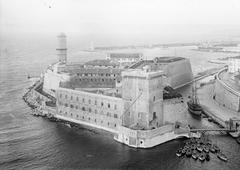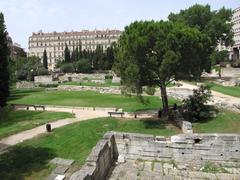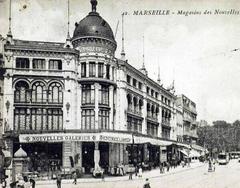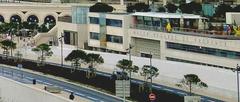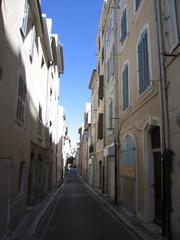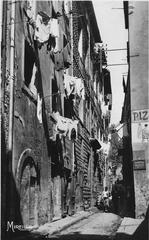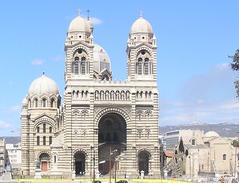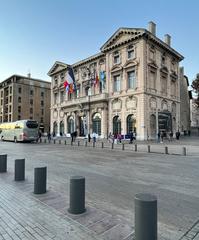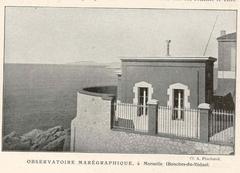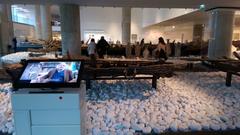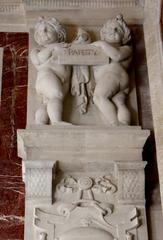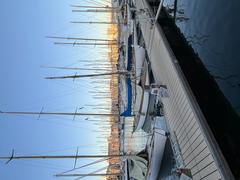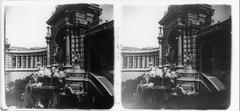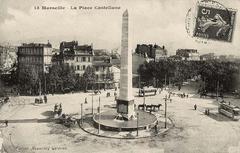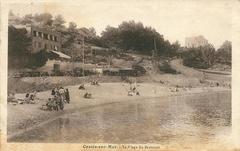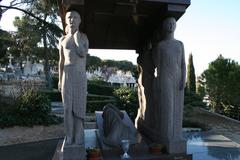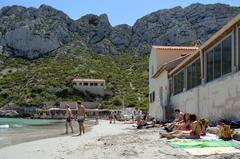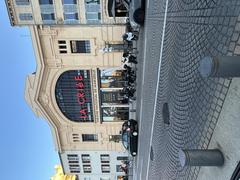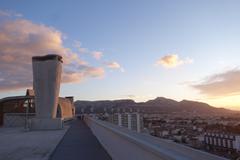
Opéra de Marseille Visiting Hours, Tickets, and Historical Site Guide
Date: 14/06/2025
Introduction: The Cultural Heart of Marseille
Nestled near the historic Vieux-Port, the Opéra de Marseille is a cornerstone of Marseille’s vibrant cultural scene and an architectural marvel. With origins dating back to the late 17th century, this opera house has played a pivotal role in shaping the city’s identity, serving as both an artistic beacon and a symbol of resilience. The current building, an elegant blend of neoclassical and Art Deco styles, is France’s largest Art Deco theater, captivating visitors with its grand colonnade, lavish interiors, and nearly 1,800-seat auditorium renowned for its acoustics.
Whether you are an opera lover, architecture enthusiast, or a traveler exploring Marseille’s rich heritage, this guide provides comprehensive insights into the Opéra de Marseille’s history, architecture, visiting hours, ticketing, accessibility, and nearby attractions. Discover how the opera house continues to thrive as a hub of creative expression and urban life (marseille.fr, marseilletourisme.fr, marvellous-provence.com).
Contents
- Introduction
- History of the Opéra de Marseille
- Early Origins and the Grand Théâtre
- The 1919 Fire and Art Deco Reconstruction
- Architectural and Artistic Highlights
- Visiting Information
- Visiting Hours
- Tickets and Pricing
- Accessibility
- Guided Tours and Events
- Travel Tips
- Annual Programming and Season Highlights
- Community Engagement and Urban Integration
- Nearby Attractions
- Restoration and Preservation
- Frequently Asked Questions (FAQ)
- Conclusion
- Sources
History of the Opéra de Marseille
Early Origins and the Grand Théâtre
Opera in Marseille began in 1685 when Pierre Gaultier, with authorization from Jean-Baptiste Lully, inaugurated the city’s first “théâtre privilégié” in a former jeu de paume on Rue Pavillon. This marked Marseille as a pioneer in French provincial opera (Wikipedia). The Grand Théâtre, inaugurated in 1787, became only the second grand opera house in France after Bordeaux, reflecting Marseille’s growing cultural ambition (marseille.fr).
The 1919 Fire and Art Deco Reconstruction
A catastrophic fire in 1919 destroyed most of the Grand Théâtre’s interior, sparing only its exterior walls and iconic colonnade. The post-war reconstruction, led by Gaston Castel in the 1920s, resulted in a harmonious blend of neoclassical grandeur and bold Art Deco innovation. The new opera house was inaugurated in 1924 and stands today as France’s largest Art Deco auditorium (opera-odeon.marseille.fr).
Architectural and Artistic Highlights
The Opéra de Marseille’s architecture is a testament to both resilience and creative excellence:
- Exterior Façade: The neoclassical colonnade and original outer walls survived the 1919 fire. An inscription above the entrance—“L’art reçoit la beauté d’Aphrodite, le rhythme d’Apollon, l’equilibre de Pallas – et il doit à Dionysus le mouvement et la vie”—encapsulates the opera’s dedication to the ideals of beauty, rhythm, balance, and vitality (marvellous-provence.com).
- Interior Design: The building’s Art Deco style is reflected throughout the foyer and public spaces with marine-themed mosaics, gilded theatrical masks, and monumental turquoise Sèvres urns. The auditorium features unobstructed seating for 1,800 guests, superior acoustics, and decorative bas-reliefs and sculptures by artists such as Antoine Bourdelle.
- Restoration: Significant restoration works, including those in 2013 during Marseille’s tenure as European Capital of Culture, have preserved the building’s splendor (marvellous-provence.com).
Visiting Information
Visiting Hours
- Box Office: Monday to Saturday, 10:00 AM – 6:00 PM.
- Performance Days: The building opens one hour before showtime, with most performances starting at 8:00 PM and weekend matinees at 2:30 PM.
- Guided Tours: Offered during special events (e.g., “Tous à l’Opéra” in May, “Journées du Patrimoine” in September). Check the official website for up-to-date schedules.
Tickets and Pricing
- Purchase Options: Tickets can be bought online, at the box office (2 rue Molière), or by phone. Early booking is advised for popular events (madeinmarseille.net).
- Pricing: Varies by performance and seat category. Discounts are available for students, seniors, and groups. Subscription packages offer added benefits for regular attendees.
Accessibility
- Facilities: Wheelchair-accessible entrances, elevators, and seating; accessible restrooms on every level.
- Assistance: Advance reservation is recommended for accessible seating and services.
Guided Tours and Events
- Backstage Tours: Available during designated events, offering a behind-the-scenes look at the auditorium, stage, and artistic spaces.
- Educational Programs: Workshops and guided visits for schools and young audiences foster appreciation for the performing arts (opera-online.com).
Travel Tips
- Location: 2 rue Molière, 13001 Marseille, near Metro station “Vieux-Port – Hôtel de Ville.”
- Transport: Accessible by metro, bus, and bicycle. Public parking is limited; public transit is recommended.
- Amenities: Staffed cloakroom, accessible restrooms, and a bar serving refreshments before performances and during intermissions.
Annual Programming and Season Highlights
The Opéra de Marseille’s season runs from September to June, featuring a blend of grand operas, ballets, symphonic concerts, and recitals. The 2024–2025 centenary season will highlight Italian opera and celebrate local composers such as Ernest Reyer. The opera house regularly collaborates with renowned guest artists and regional ensembles, presenting both classic and contemporary works (opera-online.com).
Community Engagement and Urban Integration
The Opéra de Marseille is deeply embedded in Marseille’s civic life:
- Community Outreach: Educational initiatives, open days, and collaborations with local museums and the Conservatoire Pierre Barbizet foster broad participation.
- Urban Space: Its forecourt hosts public performances and events, such as the monthly “Sirènes et Midi Net” and flashmobs, reinforcing the opera’s role as a gathering place.
- District Identity: The surrounding Opéra district is a lively hub for restaurants, cafés, and shops catering to theatergoers and tourists (marseilletourisme.fr).
Nearby Attractions
Enhance your visit by exploring these nearby Marseille historical sites:
- Vieux-Port (Old Port): The city’s bustling harbor, lined with cafés and markets.
- Le Panier District: Marseille’s oldest neighborhood, with narrow streets and artisan shops.
- MuCEM: The Museum of European and Mediterranean Civilisations, renowned for its striking architecture.
- Basilique Notre-Dame de la Garde: Offering panoramic city views.
Restoration and Preservation
Ongoing conservation ensures the Opéra de Marseille remains a vibrant cultural landmark. Restoration projects focus on preserving both its historic façade and Art Deco interiors, balancing tradition with modern amenities (marseille.fr).
Frequently Asked Questions (FAQ)
Q: What are the Opéra de Marseille visiting hours?
A: The box office is open Monday to Saturday, 10:00 AM to 6:00 PM. Performance and tour hours vary; always check the official website before visiting.
Q: How can I buy tickets?
A: Tickets are available online, at the box office, or by phone. Early booking is recommended, especially for popular productions.
Q: Is the Opéra accessible for people with disabilities?
A: Yes, the building offers wheelchair access, elevators, accessible seating, and restrooms. Assistance is available by advance request.
Q: Are guided tours available?
A: Yes, especially during special events. Check the website for upcoming dates.
Q: What are some nearby historical sites?
A: The Old Port, Le Panier, MuCEM, and Basilique Notre-Dame de la Garde are all within easy reach.
Q: Can I take photos inside?
A: Photography is permitted in public areas and during tours, but not during performances.
Visuals and Media
- Exterior façade with neoclassical colonnade (alt=“Opéra de Marseille exterior façade with neoclassical colonnade”)
- Interior Art Deco marine-themed mosaic floor (alt=“Art Deco marine-themed mosaic floor at Opéra de Marseille”)
- Auditorium seating and stage (alt=“Opéra de Marseille auditorium with unobstructed seating and stage”)
All images use descriptive alt text for SEO and accessibility.
Conclusion
The Opéra de Marseille is more than a historic venue—it is a living cultural institution that encapsulates Marseille’s enduring passion for the performing arts. Its architectural splendor, dynamic programming, and community engagement make it a must-visit for anyone seeking to experience the city’s artistic vibrancy. Plan your visit, secure your tickets, and immerse yourself in the rich legacy of one of France’s most iconic opera houses. For the latest information, consult the official website, download the Audiala app for guided tours and exclusive content, and follow on social media for news and events.



